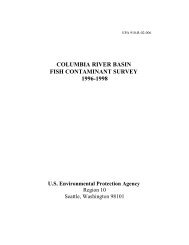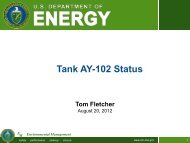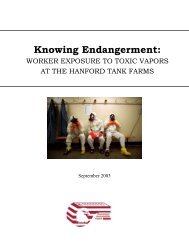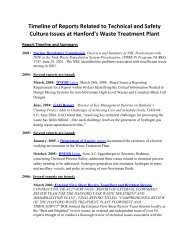Reducing the Risks of High-Level Radioactive Wastes at Hanford
Reducing the Risks of High-Level Radioactive Wastes at Hanford
Reducing the Risks of High-Level Radioactive Wastes at Hanford
Create successful ePaper yourself
Turn your PDF publications into a flip-book with our unique Google optimized e-Paper software.
62 Alvarez<br />
Table 3: Summary <strong>of</strong> melter-rel<strong>at</strong>ed incidents in <strong>the</strong> DOE. (Continued)<br />
Incident Corrective action Lessons learned<br />
Oak Ridge N<strong>at</strong>ional<br />
Labor<strong>at</strong>ory A radioactive<br />
waste In situ Vitrific<strong>at</strong>ion<br />
Plant experienced a<br />
steam explosion which<br />
resulted in <strong>the</strong> release <strong>of</strong><br />
<strong>of</strong>f gas and an expulsion<br />
<strong>of</strong> 20,000 kgs <strong>of</strong> molten<br />
glass, spewing fragments<br />
100 m from <strong>the</strong> melter<br />
site. (1996)<br />
<strong>Hanford</strong> A large-scale test<br />
<strong>of</strong> In situ Vitrific<strong>at</strong>ion on a<br />
buried 6000-gal tank<br />
resulted in a steam<br />
explosion which raised<br />
<strong>the</strong> <strong>of</strong>f-gas hood 12 in.<br />
from <strong>the</strong> ground and <strong>the</strong><br />
expulsion <strong>of</strong> molten soil.<br />
(1991)<br />
Recommended corrective<br />
actions included diversion<br />
<strong>of</strong> standing w<strong>at</strong>er around<br />
<strong>the</strong> pit, install<strong>at</strong>ion <strong>of</strong><br />
flow-monitors and curved<br />
vent pipes bene<strong>at</strong>h <strong>the</strong><br />
melt to provide altern<strong>at</strong>e<br />
p<strong>at</strong>hs for steam, submelt<br />
pressure measurement,<br />
and video monitoring <strong>of</strong><br />
<strong>the</strong> melt surface.<br />
The facility was shut down.<br />
Melters should have<br />
safeguards<br />
designed to<br />
account for not only<br />
normal oper<strong>at</strong>ing<br />
conditions, but also<br />
for abnormal<br />
conditions such as<br />
steam explosion.<br />
The cause was<br />
ascribed to sealing<br />
<strong>of</strong> <strong>the</strong> walls <strong>of</strong> <strong>the</strong><br />
tank to <strong>the</strong> melt<br />
body precluding<br />
normal p<strong>at</strong>hway for<br />
dissip<strong>at</strong>ion <strong>of</strong> steam<br />
from <strong>the</strong> melt.<br />
Sources: Vijay Jain, Process Safety Issues Associ<strong>at</strong>ed with Melter Oper<strong>at</strong>ions During Vitrific<strong>at</strong>ion<br />
<strong>of</strong> <strong>Radioactive</strong> <strong>Wastes</strong>, Proceedings <strong>of</strong> <strong>the</strong> XVIII Intern<strong>at</strong>ional Congress on Glass, 2000, and<br />
ORNL/ER-371.<br />
effects <strong>of</strong> chemical hazards.... The normally accepted practice and NRC<br />
regul<strong>at</strong>ory emphasis are minimiz<strong>at</strong>ion <strong>of</strong> <strong>the</strong> reliance upon administr<strong>at</strong>ive<br />
controls.” 100<br />
A key safety concern where engineering controls are important is firepro<strong>of</strong>ing<br />
and fire suppression. The Waste Tre<strong>at</strong>ment Plant will be handling large<br />
quantities <strong>of</strong> flammable m<strong>at</strong>erials. However, DOE and its contractors are cutting<br />
costs by reducing steel firepro<strong>of</strong>ing and fire suppression requirements. In<br />
2000, <strong>the</strong> NRC objected to this approach because it would “severely limit any<br />
future modific<strong>at</strong>ions” and “lack <strong>of</strong> fire suppression capability along with lack <strong>of</strong><br />
steel protection in <strong>the</strong> same area makes administr<strong>at</strong>ive control <strong>of</strong> combustibles<br />
<strong>the</strong> only defense measure . . .” 101<br />
In April 2003, <strong>the</strong> Office <strong>of</strong> Environmental Management’s Director <strong>of</strong> for<br />
Safety and Engineering <strong>at</strong> DOE’s Headquarters, reiter<strong>at</strong>ed <strong>the</strong> NRC’s concerns<br />
regarding a decision made by ORP to reduce fire protection requirements <strong>at</strong><br />
<strong>the</strong> Waste Tre<strong>at</strong>ment Plant. 102 It was pointed out th<strong>at</strong> one <strong>of</strong> <strong>the</strong> areas, which<br />
was given a “low” combustible r<strong>at</strong>ing would have to withstand fires th<strong>at</strong> are<br />
“equivalent <strong>of</strong> 2,370 pounds <strong>of</strong> wood in an area <strong>the</strong> size <strong>of</strong> an individual <strong>of</strong>fice.”<br />
Moreover, “<strong>the</strong> construction contractor has also proposed a combustible<br />
decontamin<strong>at</strong>ion co<strong>at</strong>ing in lieu <strong>of</strong> stainless steel on all surfaces which will<br />
appreciably add to <strong>the</strong> combustible loading in <strong>the</strong>se spaces.” 103<br />
Like <strong>the</strong> NRC, <strong>the</strong> headquarters review found th<strong>at</strong> “administr<strong>at</strong>ive controls<br />
are not an approach th<strong>at</strong> would be intentionally selected for new facilities







